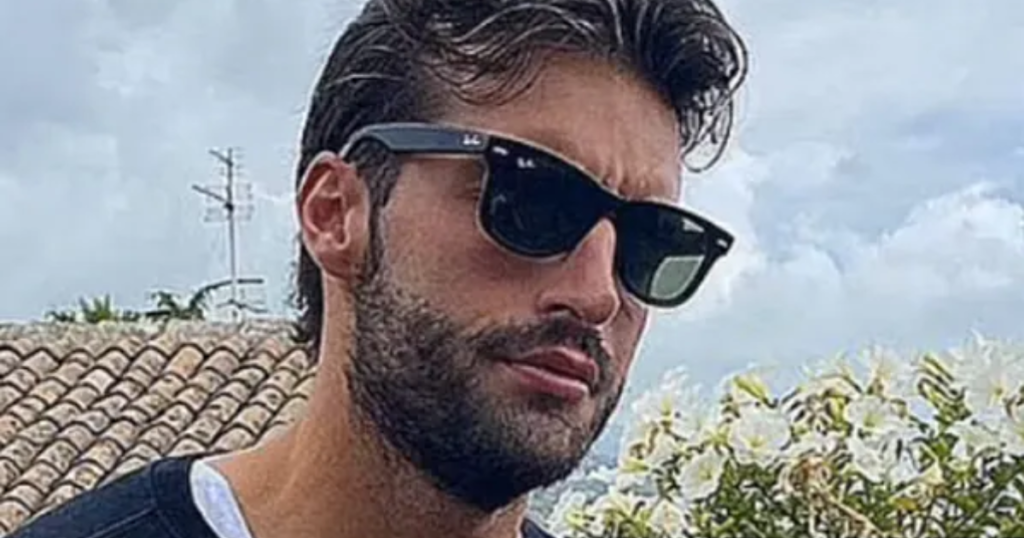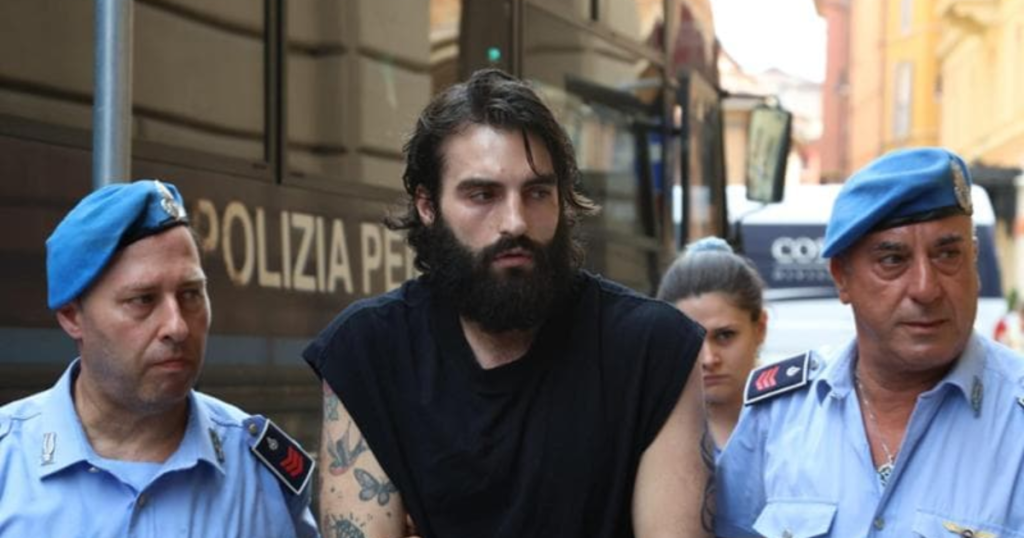In Bologna, Italy, Alessandra Matteuzzi lived a life defined by grace, discipline, and heartfelt devotion. At 56, she worked as a sales representative for a women’s fashion boutique, where she was admired not just for her refined style, but for her quiet empathy. Those closest to her described her as thoughtful and dependable—someone who moved through the world with care and intention.
Long before she met Giovanni Padovani, Alessandra’s days revolved around family. She had taken care of her ailing father during the final years of his life, a responsibility she bore without complaint, but which left her emotionally depleted after his death. Her mother, living in a care facility and in need of ongoing support, became her next focus. Each day was anchored by calls to her younger sister, Stefania, and frequent visits to the care home. Alessandra’s world was small, but full of purpose.
Though she preferred a quiet lifestyle, Alessandra wasn’t entirely disconnected. Her social media reflected her taste and structure—elegant clothing from work, family dinners, peaceful moments with her pet. She wasn’t a social butterfly, but she cherished meaningful bonds. Her posts revealed a woman content with solitude, yet still open to connection.

The Summer That Changed Everything
In the summer of 2021, Alessandra’s routine shifted with a message. She had come across the profile of Giovanni Padovani, a 26-year-old football player from Sicily. He was tall, fit, and charismatic—a professional athlete with a growing following online, thanks to his modeling gigs and sports career. His social media featured clips of training sessions, travels, and styled photo shoots. His online persona exuded confidence, yet appeared approachable.
What started as a casual exchange quickly blossomed into something deeper. Giovanni Padovani was respectful, attentive, and kind. Despite the 30-year age gap, they found themselves drawn to one another through daily messages. Their chats evolved from friendly check-ins to intimate conversations. And soon, Giovanni decided to visit her.
Giovanni Padovani traveled to Bologna and met Alessandra in person. He was courteous, even visiting her mother at the care facility—a gesture that deeply touched Alessandra. His presence in her life seemed sincere. He didn’t shy away from the rhythms of her world; instead, he joined her for walks, meals, errands. He gave the impression of someone genuinely invested.
Photos from their time together occasionally appeared on his social accounts. In private, he sent her messages of warmth and support. For Alessandra, who had once turned inward after heartbreak, this felt like an unexpected new beginning.
Read more The Murder of Margaret Sumney: A Mother Betrayed
The Shift in Tone
But by early 2022, something in Giovanni Padovani began to change. His messages became more frequent and his tone more demanding. What started as affection morphed into interrogation. He called repeatedly, questioning her every move—who she was speaking to, where she was going, why she hadn’t answered sooner.
He accused her of hiding things. The gentle charm was now overshadowed by jealousy and control.
Even Stefania, once viewed as a neutral observer, was pulled into the chaos. Giovanni Padovani began contacting her directly, attempting to convince her that Alessandra was being dishonest. His calls became more aggressive, his words more unhinged. Stefania, shaken by his behavior, eventually severed all communication.
Alessandra, ever calm, tried to manage the situation with patience. She didn’t fight back. Instead, she sought to de-escalate, believing that with time, Giovanni’s anger might subside. She held onto the hope that the kind, gentle man she had first met would return.
But she didn’t know how far things had already spiraled.
Behind the scenes, Giovanni Padovani was becoming consumed. His fixation deepened. And Alessandra, once the center of a quiet and orderly life, found herself entangled in the unpredictable emotions of a man she had let into her most private world.

Digital Triggers, Real-World Fear
What began as a whirlwind romance soon spiraled into an emotional siege. By early 2022, Giovanni Padovani’s jealousy was no longer subtle. Simple actions—liking a photo, replying to a comment, or updating a status—ignited heated arguments. What once passed for affection quickly revealed itself as control. He demanded explanations for even the most ordinary online activity.
His calls came at random hours, sometimes deep into the night. The messages poured in—long, frantic, accusatory, and relentless. Some were furious. Others begged for forgiveness. The Alessandra who once enjoyed quiet evenings was now caught in a storm of psychological pressure.
One morning, Alessandra discovered she had been locked out of her email. Then, her social media accounts. When she attempted to reset them, she noticed something odd—password hints that echoed Giovanni’s words and references. She began to piece things together: her privacy had been breached.
A closer look at her devices revealed even more disturbing truths. Her WhatsApp was connected to an unknown device. Later, technicians found spyware installed on her phone—software capable of reading messages, tracking locations, even logging phone calls. It wasn’t guesswork. Giovanni Padovani had constructed a digital prison around her.
Every Move Watched
The most terrifying part was what followed. Giovanni Padovani began mentioning private things Alessandra had only said in confidence. Conversations with friends. Specific times she had gone out. He accused her of hiding things. Cheating. Lying. None of it was real—but his belief was unshakable.
He didn’t just demand explanations anymore. He wanted proof. He instructed Alessandra to send short videos of herself every ten minutes—evidence of her location and companions. If she refused, he would erupt—blaming her, punishing her with a barrage of messages, or threatening to disappear altogether.
The final rupture came with a message to his own mother. Attached was a screenshot—an image from inside Alessandra’s home, taken through her own security camera system. Somehow, Giovanni had accessed her private surveillance feed. The place where she felt most secure had become another window through which he watched.
His intrusion was no longer limited to the digital world.

By mid-2022, Giovanni had become a physical presence in her daily life. He began appearing near her building in Bologna, lurking by entrances, walking the neighborhood, waiting. Residents reported seeing him around—one neighbor even saw him climbing onto the building’s rooftop. He was watching. Waiting. Looking for a way in.
Then, the harassment turned to sabotage. The electrical fuses in Alessandra’s apartment were removed. Her car’s lights were disabled. She would come home to find things broken or out of place. Loud banging shook the walls. Shouting came from outside her windows. These were not random acts of chaos—they were calculated attempts to break her spirit and isolate her.
Living in Fear
Alessandra no longer moved through her days with ease. Fear dictated every step. She started carrying pepper spray—a small act of self-preservation that marked a significant emotional shift. At times, she sought shelter at her sister Stefania’s home, but could never stay away too long. Her dog was still at the apartment. And love for her loyal companion always pulled her back.
Inside, her home felt more like a trap than a refuge.
Between July and August, Alessandra began to confide more in Stefania. She described the late-night appearances, the digital intrusions, and the stalking. But even then, Alessandra avoided confrontation. She hoped, perhaps, that distance would send a message. That silence might cool his temper. But for Giovanni Padovani, withdrawal wasn’t a boundary—it was a challenge.
Seeking Protection
On July 29, 2022, Alessandra finally took a formal step. She filed a police report. She documented the hacking, the stalking, the break-ins, and the surveillance. It was a brave move—but one she made far too late in the escalation. Giovanni’s obsession wasn’t losing momentum.
It was accelerating.
Alessandra Matteuzzi walked into the police station on her own, prepared and composed. She brought evidence—screenshots of disturbing messages, photographs of Giovanni Padovani near her residence, and a detailed timeline of his stalking behavior. Her goal was simple: protection.
But nothing urgent followed.
No officers were stationed at her building. No restraining order was issued. The report was filed, and the system moved at its own slow pace. Alessandra went home with her fear still intact.

Five days later, on August 3, Alessandra returned to the police with new documentation. She reported additional sightings, more signs of tampering near her home, and further intimidation. Again, her statements were taken. Again, there was no tangible action.
When she came back on August 8, the harassment had escalated. Giovanni Padovani had tried—yet again—to enter her building. She detailed the damaged car, the electrical sabotage, the break-in attempts. His messages were turning darker, more threatening.
Still, authorities held back. They cited procedural steps. No emergency measures were implemented.
By her fourth visit, on August 13, Alessandra was physically and emotionally depleted. She described her daily life under surveillance—every message she sent, every step she took felt watched and judged. She quoted his texts, many of which contained threats masked as emotional breakdowns.
One statement cut through everything:
“I don’t want to die.”
It wasn’t a figure of speech. It was a last attempt to be taken seriously.
Bureaucracy Over Urgency
Police officials acknowledged her concerns—but pointed to legal limitations. Because Giovanni Padovani had not yet committed a physical assault, they classified the case as ongoing harassment, not imminent danger. Some cited delays due to staff shortages and summer vacation schedules.
The warnings were seen as cautionary, not critical.
Her family, especially Stefania, would later speak out—insisting the signs had been undeniable. Giovanni’s behavior had shifted from obsessive to predatory. He wasn’t reacting out of heartbreak; he was executing a plan.
That plan became disturbingly clear on August 20, 2022. In his phone’s Notes app, Giovanni Padovani had created a checklist. Investigators would later retrieve it, and what they found erased all doubt.
Listed items:
- Duct tape
- Hammer
- Restraints
Beneath it was a strategy:
Simulate a normal conversation. Gain entry. Use the tools. Finish what was planned.
This wasn’t impulsive rage. It was premeditated violence.

Read more Brittany Steier: A Life Stolen by the One She Trusted
Closing In
The very next day, August 21, Giovanni left Sicily under the pretense of personal business. He stopped in Senigallia, then made his way to Bologna by August 22.
He told no one he was coming—not even Alessandra.
Digital tracking later confirmed his movements. Upon arrival, he hid a hammer in the bushes near Alessandra’s apartment complex—tucked in a shadowed corner he had scouted in advance. He returned later that day and climbed to the building’s rooftop, watching from above.
This wasn’t the first time he’d surveilled her, but this time, he wasn’t just watching.
What sealed the story of intent wasn’t just the checklist—it was another note he had written earlier that summer. Dated July 2, it read:
“I’ll end her because she ended me emotionally.”
“I know I’ll end up in prison. This note will explain to the police what she did to me.”
The words revealed a warped justification. In his mind, he was not an aggressor—but a man driven to act. He saw punishment as inevitable and violence as deserved.
The Fatal Encounter
On the evening of August 23, 2022, Alessandra returned home around 9:00 PM. She was on the phone with her sister Stefania—something they did almost daily. Their conversation was ordinary, familiar.
As Alessandra neared the entrance to her apartment building, Giovanni Padovani emerged.
The attack was swift and savage.
Stefania, still on the call, heard Alessandra’s voice shift from calm to alarm. Then came muffled noises—scuffling, shouting, the unmistakable sound of impact. She could do nothing but listen.
Witnesses reported seeing Giovanni Padovani lunge. He retrieved the hammer he had hidden and struck Alessandra so forcefully that the tool’s head snapped off. But he didn’t stop.
He beat her with his fists.

Then he lifted a heavy wrought iron bench—the kind meant for rest, not violence—and brought it crashing down on her again and again.
It was brutal. It was relentless. It was the end of everything Alessandra had feared—and everything the system failed to prevent.
A Brutal End
When forensic teams examined the scene, the brutality of the attack became horrifyingly clear. Alessandra Matteuzzi had sustained over 20 separate injuries. Her skull was fractured. Her chest, arms, and legs bore deep signs of blunt force trauma. Evidence at the scene showed she had been dragged across the pavement. It was not a spontaneous act of rage—it was an explosion of pent-up control, executed with terrifying precision.
Even more chilling was what followed: Giovanni Padovani didn’t flee.
He remained at the building entrance, sitting near the front door. When police arrived, he didn’t resist. Officers described his demeanor as oddly serene.
“Good thing you came,” he reportedly told them.
No panic. No attempt to hide what he had done. Just calm acceptance.
Alessandra was still alive when emergency services arrived, but only barely. She died within minutes of reaching the hospital. Her injuries were beyond saving.
The Evidence Was Overwhelming
Every part of the investigation pointed to a premeditated act. The hidden hammer. The surveillance. The checklist. Witness accounts described Padovani as deliberate, focused—moving with the confidence of someone who had played out the attack in his mind many times before.
The call with Stefania became a crucial piece of evidence, as did the forensic data and Giovanni’s digital footprint. The entire assault had lasted only minutes—but it was the tragic peak of months of escalating obsession.
After his arrest, Giovanni Padovani was transferred to a psychiatric facility for observation. At first, he refused to speak. But when he finally broke his silence, his statements followed a familiar pattern—blame.
He said Alessandra had emotionally destroyed him. That she had driven him to the edge.
But investigators weren’t convinced.
The planning, the travel, the preparation—it all suggested intention, not breakdown. Though his legal team lobbied for a psychiatric defense, court-appointed experts evaluated him and found no signs of legal insanity. He was obsessive. Controlling. But he was fully aware of what he had done.
His mind was sound. His motives were clear.
Read more Bree Kuhn’s Final Call: Self-Defense or Cold Blood?
The Verdict
On February 12, 2024, the court delivered its decision.
Giovanni Padovani was found guilty of stalking and the premeditated murder of Alessandra Matteuzzi. The sentence: life in prison.
The court cited aggravating factors, including the extreme violence of the crime, his lack of remorse, and the sustained psychological torment he inflicted leading up to Alessandra’s death.
At sentencing, he addressed the court briefly. He called the whole situation a “nightmare” and said if they truly believed he was sane, then he deserved the harshest punishment.
His performance failed to sway the court.

Public Backlash and a Second Injustice
But Alessandra’s suffering didn’t end with her death—or with the trial.
In the days that followed, her name and image began circulating widely across news and social media platforms. What came next shocked the nation: a wave of cyberbullying targeted not the killer, but the victim.
Trolls mocked her appearance. Her age. Her fashion choices. The 30-year age gap between her and Giovanni Padovani became a point of ridicule. Some even suggested she bore responsibility for the crime.
Among the worst came from an unexpected source: Donatello Alberti, a senior official in the Red Cross’s regional branch. In a public post, he implied that Alessandra’s appearance might have triggered Giovanni’s jealousy.
The reaction was immediate. Alberti was removed from his position.
Alessandra’s family fought back, filing formal complaints against 25 individuals for online abuse. In a landmark move, the prosecutor’s office in Bologna launched an investigation into cyber defamation against a deceased victim—a rare and groundbreaking case in Italian law.
A Case That Changed the Conversation
Alessandra’s murder became more than a crime—it became a national reckoning.
Experts later identified Giovanni’s behavior as symptomatic of Othello syndrome, a delusional disorder rooted in pathological jealousy. Sufferers of this condition obsess over imagined infidelities, incapable of distinguishing their fears from reality. In extreme cases, it leads to violence.
And for Alessandra, it led to death.
Her story now serves as a warning—about the dangers of overlooked signs, the failures of institutional systems, and the need to recognize emotional abuse for what it is: a precursor to something much darker.


